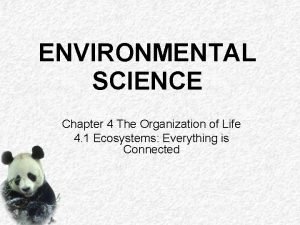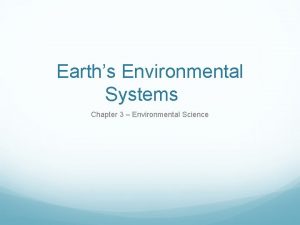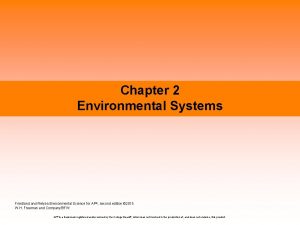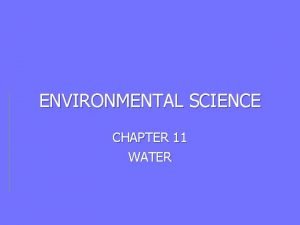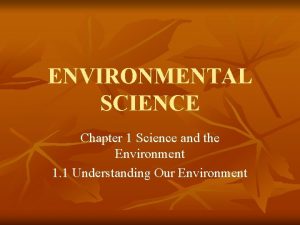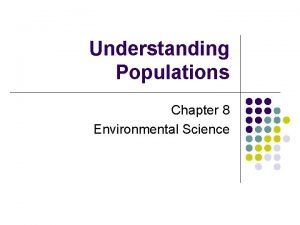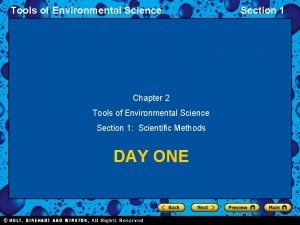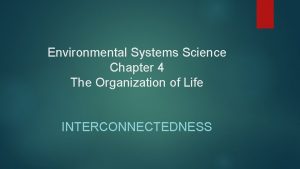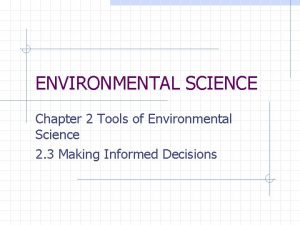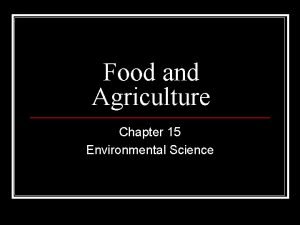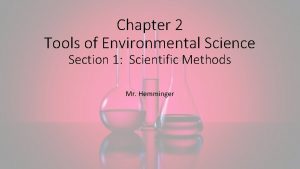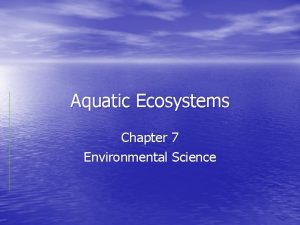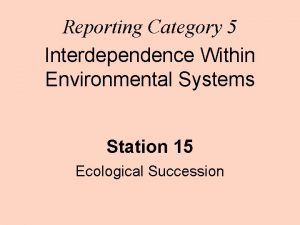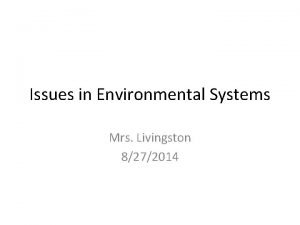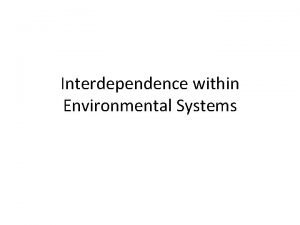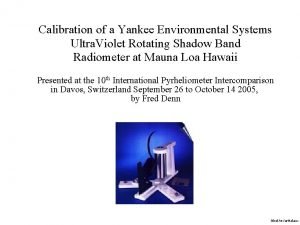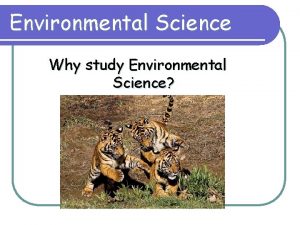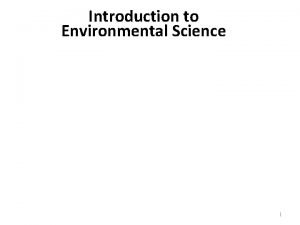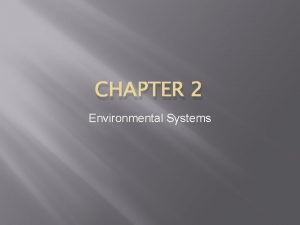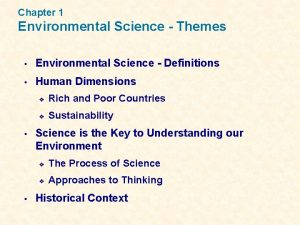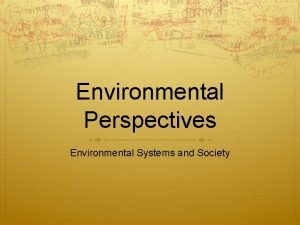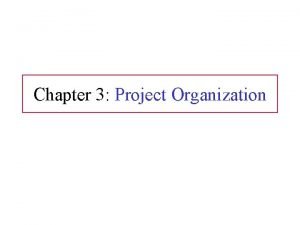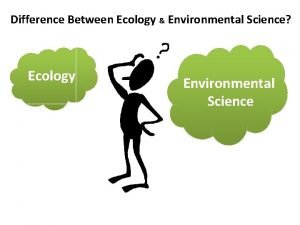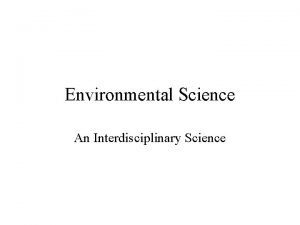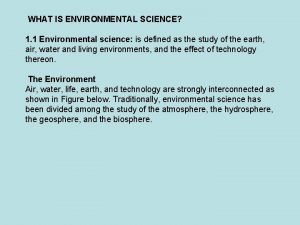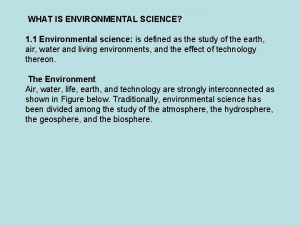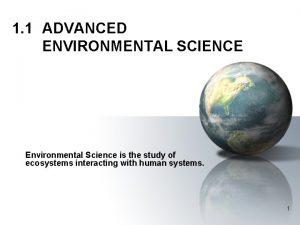Environmental Systems Science Chapter 4 The Organization of






































- Slides: 38

Environmental Systems Science Chapter 4 The Organization of Life INTERCONNECTEDNESS

Interconnectedness Inter· connected· ness Inter Between/inside Connected Joined Ness State together

Objectives Understand the importance of the relationships (interconnectedness) between the different components of an ecosystem. Explain how the destruction of one part of an ecosystem can impact an entire system. Describe the effects of bioaccumulation and biomagnification in an ecosystem.

China: The Great Leap Forward Mao Ze. Dong started what was called “The Great Leap Forward” in 1958. He believed that focusing on industry, agriculture, health and cleanliness would make China great.

China: The Great Leap Forward He frequently used propaganda to inspire enthusiasm. What is propaganda? ___________ What does this poster represent to you?

China: The Great Leap Forward Four Pests Campaign Part of his plan was to completely eliminate four specific species: Mosquitoes Rats Flies Sparrows

Four Pests Campaign Why do you think these specific four species were targeted ? (Remember Mao was focused on health, cleanliness, industry and agriculture. ) Mosquitoes Health/Cleanliness Rats Health/Cleanliness Flies Health/Cleanliness Sparrows Agriculture

Four Pests Campaign It’s been reported that Mao knew very little about animals or ecosystems and did not discuss his plans or listen to his advisors. At this point in history, China’s communism was built on Marxism. Marx believed that “nature should be fully exploited by humans for production purposes. ”

Four Pests Campaign As the campaign began, the elimination of one particular species had an almost immediate significant negative impact on the entire ecosystem. (Can anyone guess which one? ) The Four Pests Campaign has also been called The Great Sparrow Campaign.

Four Pests Campaign Sparrows had been targeted as opposed to other species because Chinese scientists had “calculated” that each sparrow ate 4. 5 kg (10 pounds) of grain each year. They projected that for every million sparrows killed, there would be food for 60, 000 people.

Four Pests Campaign People gathered in massive numbers to eliminate the sparrows. Sparrows were shot. They were prevented from landing until they dropped out of the sky from exhaustion. Their chicks were killed and their nests were destroyed.

Propaganda

Propaganda

Four Pests Campaign Citizens were rewarded by the number of sparrows they killed. The number of sparrows was drastically reduced until they almost became extinct.

Four Pests Campaign BUT … Sparrows serve an important function in an agricultural ecosystem by eating locusts. With very few predators, the locust population exploded, and China’s crops were devastated. Mao finally acknowledged that sparrows actually prefer to eat insects rather than grain.

Four Pests Campaign Mao called off the campaign, but it was already too late. Swarming locusts, coupled with drought, led to The Great Chinese Famine. This famine spanned three years.

The Great Chinese Famine It is reported that between 15 - 75 million people died of starvation and disease. The Four Pests Campaign has been called China’s “worst self inflicted environmental disaster. ”

Four Pests Campaign How does this relate back to our objectives? Understand the importance of the relationships between the different components of an ecosystem. Explain how the destruction of one part of an ecosystem can affect an entire system.

Lesson learned? “The lesson will be repeated until it is learned. ”

ANOTHER EXAMPLE

The Day Cats Parachuted Into Borneo

The Day Cats Parachuted Into Borneo Based on what you know about ecosystems, work with a neighbor to arrange these events in the order they happened: _____ Rats brought plague. _____ Mosquitos caused a malaria outbreak. _____ Cats died. _____Lizards ate roaches. _____ DDT was sprayed. _____Cats ate lizards. _____ Number of rats increased. _____DDT killed roaches. _____ Roaches store DDT in their bodies.

The Day Cats Parachuted Into Borneo In the 1950's, the Dayak people of Borneo suffered an outbreak of malaria, spread by mosquitoes. The World Health Organization (WHO) sprayed the area with DDT to kill the mosquitoes. The mosquitoes died and the number of cases of malaria decreased. Happy Ending? ?

The Day Cats Parachuted Into Borneo Problems set in … The grass (thatch) roofs of the villagers began to collapse. Initially, scientists thought an ingredient in DDT caused the roofs to rot or decay.

The Day Cats Parachuted Into Borneo After researching the problem, scientists discovered that DDT killed a type of wasp that had been controlling the number of thatch-eating caterpillars. The caterpillars were not harmed by DDT, and as they thrived, roofs collapsed.


The Day Cats Parachuted Into Borneo More consequences: Cats began to die and the number of rats increased. One theory as to why this was happening was bioaccumulation. Bioaccumulation refers to how and where substances such as pesticides or other chemicals enter and accumulate in the food chain. The cats were poisoned from different sources. They were exposed to poison in their houses as well as from their food.

The Day Cats Parachuted Into Borneo Another theory was biomagnification. Biomagnification refers to the increasing concentration of a substance, such as a toxic chemical, in the tissues of organisms at successively higher levels in a food chain. For example, each roach stored DDT. Geckos ate multiple roaches, and cats ate multiple geckos. The cats also could also have been poisoned by eating rats that had fed on the grains and other crops sprayed with DDT.

Biomagnification

The Day Cats Parachuted Into Borneo New health threats emerged from an abundance of rats Plague Typhus

The Day Cats Parachuted Into Borneo The World Health Organization was contacted again. DDT spraying was stopped.

The Day Cats Parachuted Into Borneo Cats were air dropped or flown into the jungle to control the rat population. Rat population was reduced. Cases of plague and typhus were reduced.

The Day Cats Parachuted Into Borneo How did you do? ? 9 Rats brought plague. 1 Mosquitos caused a malaria outbreak. 7 Cats died. 5 Lizards ate roaches. 2 DDT was sprayed to kill the mosquitoes. 6 Cats ate lizards. 8 Number of rats increased. 3 DDT killed roaches. 4 Roaches store DDT in their bodies.


DDT Decades later, DDT is banned in the United States, and although controversial, is still used in parts of the world as it is effective in killing the mosquito that carries malaria.

Modern Bees Day Examples ? in Florida “If the bee disappeared off the surface of the globe, then man would have only four years of life left. No more bees, no more pollination, no more plants, no more animals, no more man. ” - Albert Einstein

Interconnectedness “Do Good Carefully” (Orang Ulu Tribesmen of Sarawak) “This is a graphic illustration of the interconnectedness of life, and of the fact that the root of problems often stems from their purported solutions. ” (Wynberg & Jardine, Biotechnology and Biodiversity, 2000)

Interconnectedness When we try to pick out anything by itself, we find it hitched to everything else in the universe. - John Muir
 Environmental science chapter 4 the organization of life
Environmental science chapter 4 the organization of life Why environmental science is an interdisciplinary science
Why environmental science is an interdisciplinary science Environmental science chapter 3
Environmental science chapter 3 Chapter 2 environmental systems
Chapter 2 environmental systems Chapter 2 environmental systems
Chapter 2 environmental systems My favorite subject is pe
My favorite subject is pe Wastewater sludge
Wastewater sludge Water that contains wastes from homes or industry
Water that contains wastes from homes or industry Environmental science chapter 1
Environmental science chapter 1 Environmental science chapter 13
Environmental science chapter 13 Chapter 19 environmental science
Chapter 19 environmental science Chapter 2 economics and environmental policy
Chapter 2 economics and environmental policy Radonrid
Radonrid Chapter 8 environmental science
Chapter 8 environmental science Environmental science section 2 review answers
Environmental science section 2 review answers Chapter 4 environmental science
Chapter 4 environmental science Chapter 2 environmental science
Chapter 2 environmental science Three levels of biodiversity
Three levels of biodiversity Chapter 9 environmental science
Chapter 9 environmental science Chapter 13 environmental science
Chapter 13 environmental science Chapter 15 environmental science
Chapter 15 environmental science Chapter 2 tools of environmental science answer key
Chapter 2 tools of environmental science answer key Limestone ridges built by tiny animals
Limestone ridges built by tiny animals Wireless health
Wireless health Levels of environmental organization
Levels of environmental organization Process organization in computer organization
Process organization in computer organization Point by point vs block organization
Point by point vs block organization Category 5 interdependence within environmental systems
Category 5 interdependence within environmental systems Category 5 interdependence within environmental systems
Category 5 interdependence within environmental systems Harris environmental systems
Harris environmental systems Environmental systems teks
Environmental systems teks Interdependence within environmental systems
Interdependence within environmental systems Environmental value system
Environmental value system Coastal environmental systems
Coastal environmental systems Building environmental systems
Building environmental systems Environmental value systems diagram
Environmental value systems diagram Environmental systems research institute
Environmental systems research institute Yankee environmental systems
Yankee environmental systems Environmental value system
Environmental value system
